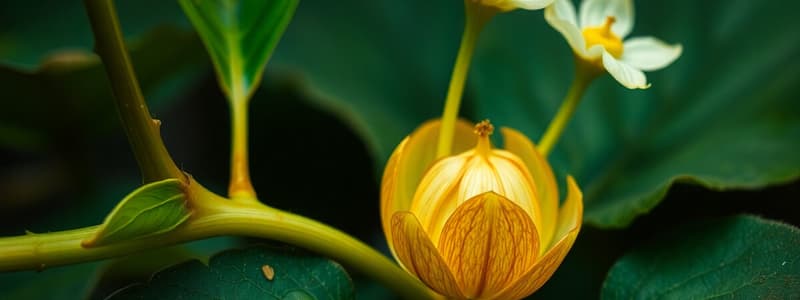Podcast
Questions and Answers
What is the main advantage of a plantlet being attached to the parent plant?
What is the main advantage of a plantlet being attached to the parent plant?
- It has less exposure to pests.
- It can produce flowers sooner.
- It requires less sunlight.
- It receives nourishment for better establishment. (correct)
In grafting, the cambium layers of the scion and root stock must unite to form one plant.
In grafting, the cambium layers of the scion and root stock must unite to form one plant.
True (A)
What type of artificial propagation involves removing part of a shoot and placing it in soil or water to develop roots?
What type of artificial propagation involves removing part of a shoot and placing it in soil or water to develop roots?
Cuttings
In layering, a cut shoot is _______ into soil to develop into a new plant.
In layering, a cut shoot is _______ into soil to develop into a new plant.
Match the type of artificial propagation with its description:
Match the type of artificial propagation with its description:
Which of the following is NOT a requirement for germination?
Which of the following is NOT a requirement for germination?
In hypogeal germination, the seed remains below the ground.
In hypogeal germination, the seed remains below the ground.
What is the role of oxygen in the process of germination?
What is the role of oxygen in the process of germination?
The ______ is the first part of the plant to emerge during germination.
The ______ is the first part of the plant to emerge during germination.
Which type of vegetative propagation involves swollen underground stems?
Which type of vegetative propagation involves swollen underground stems?
Match the following plant propagation methods with their descriptions:
Match the following plant propagation methods with their descriptions:
What is the main characteristic of asexual reproduction in plants?
What is the main characteristic of asexual reproduction in plants?
Bulbs can survive winter beneath the soil until the following year.
Bulbs can survive winter beneath the soil until the following year.
Flashcards are hidden until you start studying
Study Notes
Germination
- The process of a seed beginning to grow.
- Requirements for germination:
- Water: acts as a solvent for materials, allowing plant hormones and enzymes to function.
- Oxygen: used in aerobic respiration for energy production.
- Suitable temperature: for optimal enzyme activity.
- Food: from the seed's food reserve, providing energy and materials for new plant tissues.
- Stages of germination:
- Radicle emerges: forms the root, growing downwards.
- Plumule emerges: forms the shoot, growing upwards. Plant loses weight.
- Leaves break the surface: seedling begins photosynthesis, producing glucose for growth and new tissue. Plant gains weight.
- Hypogeal germination: seed stays underground.
- Epigeal germination: seed is carried above the ground.
Asexual Reproduction
- Reproduction without gametes, producing genetically identical offspring.
- Vegetative propagation: cloning plants.
Natural Propagation
- Stem tubers: e.g., potatoes.
- Swollen underground stems.
- Axillary buds produce new shoots and roots, using stored food.
- Parent tuber eventually dies.
- Root tubers: e.g., sweet potatoes.
- Swollen lateral roots, storing food and acting as perennating organs.
- Allows the plant to survive over multiple seasons.
- Bulbs: e.g., daffodils.
- Underground swollen buds.
- Terminal and axillary buds enclosed in food-rich leaf bases.
- Axillary buds can grow, producing foliage leaves and roots, eventually forming independent plants.
- Plantlets: e.g., strawberry plants.
- Miniature plants forming along leaf edges.
- Have roots that grow into the ground, establishing a new plant.
- Modified stems called runners grow over the ground, with plantlets at their ends.
- Runners provide initial nourishment to the plantlet.
- When established, the runner withers, and the new plant becomes independent.
Artificial Propagation
- Cuttings: e.g., geraniums.
- A shoot portion is placed in soil or water to form roots.
- Rooting powder can accelerate root development.
- Layering: e.g., blackberries.
- A cut shoot is anchored in soil, developing into a new plant.
- Adventitious roots form, and the new plant is then separated from the parent.
- Grafting: e.g., apples.
- A shoot twig (scion) is attached to a rootstock.
- Cambium layers unite, forming a single plant.
- Micropropagation: e.g., bananas.
- Individual cells (stem, root, or leaf) are grown in tissue culture.
- Used for houseplants and commercial crops.
Studying That Suits You
Use AI to generate personalized quizzes and flashcards to suit your learning preferences.




